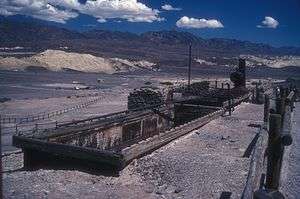Borate glass

An old borax plant in Death Valley, California.
Borate glasses have a more complex action of alkali ions than silicate glasses.[1] Borate glasses also have major differences in their optical properties.[2]
The single largest use of boron compounds in the world (accounting for half of total global use) is the production of certain types of boron-treated glass fiber for insulating and structural fiberglass. [3] In these uses the boron may be present as borax or boron oxide, and adds to the structural strength of the glass as borosilicate, or is added as a fluxing agent to decrease the melting temperature of pure silica, which is difficult to extrude as fibers and work with in pure form, due to the high temperatures involved.
References
- ↑ "Archived copy". Archived from the original on 2014-12-01. Retrieved 2013-05-28.
- ↑ http://www.hindawi.com/isrn/ceramics/2012/428497/
- ↑ http://ec.europa.eu/enterprise/sectors/chemicals/files/docs_studies/annex_use_glass_glass_fibre_en.pdf
This article is issued from Wikipedia - version of the 11/6/2016. The text is available under the Creative Commons Attribution/Share Alike but additional terms may apply for the media files.